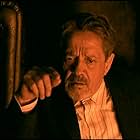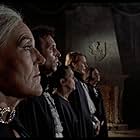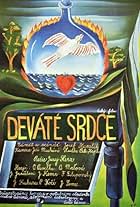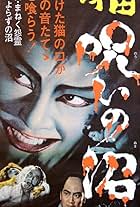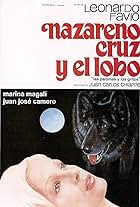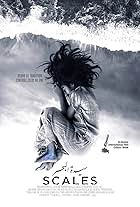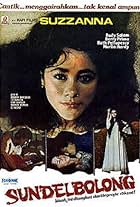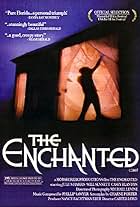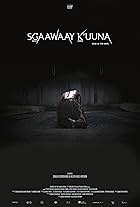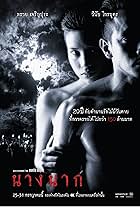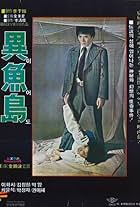Aggiungi una trama nella tua linguaIn 17th-century Navarre, Lord Fermin has started a witch hunt. Villagers are arrested and tortured to extract "confessions"; Fermin is actually using this horror to tarnish Unai, a farmer wh... Leggi tuttoIn 17th-century Navarre, Lord Fermin has started a witch hunt. Villagers are arrested and tortured to extract "confessions"; Fermin is actually using this horror to tarnish Unai, a farmer who opposes his tyrannical rule.In 17th-century Navarre, Lord Fermin has started a witch hunt. Villagers are arrested and tortured to extract "confessions"; Fermin is actually using this horror to tarnish Unai, a farmer who opposes his tyrannical rule.
- Premi
- 1 candidatura
Mary Carrillo
- Amunia
- (as Mari Carrillo)
Mariví Bilbao
- María
- (as Marivi Bilbao-Goiaga)
Trama
Lo sapevi?
- QuizOn the occasion of José Luis López Vázquez's death, director Pedro Olea recalled his performance in this film. "What better inquisitor than López Vázquez? He accepted the role and turned it into another character that was amazing: a religious sadist, cruel and libidinous. Simply, his way of brushing Silvia Munt's chest with his fingers when removing a medal, of directing another torture session with her naked and then flagellating himself in his cell, demonstrates a perfect interpretive treatment of the repression suffered by the sinister friar," he said.
Recensione in evidenza
17th C.Navarre , during the kingdom of the monarch Felipe , there Lord Fermin De Andueza (Walter Vidarte) , helped by a priest called Angel (Mikel Garmendia) and Fray Miguel (Javier Loyola) , Monastery Prior , all of them bring an inquisitor , Licenciado Azevedo (José Luis López Vázquez) from Santo Oficio . Shortly after , a witch hunt begins , villagers are detained to carry out trials against the local witches . Thanks to information given by some villagers result to be judged Gurazi De Ochoa (Silvia Munt) , niece of a burnt witch in France , and an elderly woman , Amunia De Basterrechea (Mary Carrillo). However , Fermin is using this horror to tarnish Unai (Patxi Bisquert) but he escapes .
A historic fiction crammed with witchery as well as horror touches and based on actual facts happened late XVII Century , 1595 , in Valley of Araiz , where this film was filmed , there took place an ¨Auto De Fe¨ in which were judged some witches . Olea describes a culture clash , the Catholic Castillian and the primitive Basque . The authoritarian , torturing Inquisitors against witches with medicine knowledge who get together and celebrate naked little orgies as well as firing parties at Saint Joan nights , including popular dances . Entertaining though slow-moving witchery film with abundant sensationalistic scenes and provoking style . The film displays a strong criticism against the Spanish Inquisition that travelled throughout country judging , torturing and condemning suspicious of witchery as well as experts with necromancy arts and arresting and torturing to extract 'confessions'. The movie has engaging scenes full of witchery , horrifying tortures , burning poles and several other things .
The picture compellingly written by Pedro Olea and Gonzalo Goicoechea (Eloy De La Iglesia's ordinary screenwriter) was based upon Julio Cáro Baroja books and Florencio Iruate story , specially his novel : ¨Book about witches¨. Olea gives knowledge on Inquisition and witchery , including about the ¨Fornicarius¨ and the ¨Garden of flowers ¨ by Torquemada that the devil and Sabbath are the same and particularly ¨The Malleus Malleficarum¨ that may be the most blood-soaked book in human history : the witches' hammer , it is instructed the clergy on how to locate , torture and kill all freethinking women , during witch-hunt , history tells , fifty thousand are captured , burned alive at the stake . Nevertheless , the prestigious writer Julio Caro Baroja explained the Spanish Inquisition is less interesting and did not pursue witches as happened in France or Germany . Other film dealing with witchery are : the classy ¨Haxam¨ by Benjamin Christiensen and ¨Dies Irae¨ by Carl Theodor Dreyer . In Spain was shot : ¨Flower of holiness¨ by Adolfo Marsillach and ¨Inquisition¨ by Jacinto Molina . Akelarre's cast is pretty good , such as : José Luis López Vázquez who gives a restrained acting , Mary Carrillo is awesome as old witch who has a lot of medicine wisdom and Patxi Bisquert as a farmer who opposes his rule of tyranny . Support cast is frankly well , such as : Iñaki Miramón , Javier Loyola , Sergio Mendizábal , Félix Rotaeta , Marivi Bilbao , Lola Lemos ; though most are sadly dubbed by professionals .
After six years in which Pedro Olea dedicated in advertising and documentaries as ¨Guernica¨ , ¨River of Bilbao¨ and TV series as ¨Cuentos Y Leyendas¨ , and others about Basque themes ; and later ¨Un Hombre Llamado Flor De Otoño¨ he goes back to shoot , thanks to subsidy of the Basque government . He is one of the most gripping Spanish directors , being an expert Basque director , producer and screenwriter . He began directing ¨Dias Viejo color¨ and followed a personal work titled ¨Bosque del Lobo¨ about an alleged werewolf . He subsequently directed a trilogy about Madrid , produced by Jose Frade , such as : ¨Tormento¨ , ¨Pim , Pam , Pum Fuego¨ and ¨La Corea¨ . His biggest success was ¨A man called Flor De Otoño¨ with Jose Sacristán . After that , he made ¨Bandera Negra¨ about arms smuggling and a military thriller : ¨Moriras en Chafarinas¨ ; later on , he directed ¨Mas Allá Jardin¨ with Concha Velasco . And ¨Fencing master¨ that resulted to be one of the best films . And he also shot another film about witchery : ¨Leyenda Del Cura De Bargota¨ TV (1988) . ¨Akelarre¨ rating : Above average , well worth watching .
A historic fiction crammed with witchery as well as horror touches and based on actual facts happened late XVII Century , 1595 , in Valley of Araiz , where this film was filmed , there took place an ¨Auto De Fe¨ in which were judged some witches . Olea describes a culture clash , the Catholic Castillian and the primitive Basque . The authoritarian , torturing Inquisitors against witches with medicine knowledge who get together and celebrate naked little orgies as well as firing parties at Saint Joan nights , including popular dances . Entertaining though slow-moving witchery film with abundant sensationalistic scenes and provoking style . The film displays a strong criticism against the Spanish Inquisition that travelled throughout country judging , torturing and condemning suspicious of witchery as well as experts with necromancy arts and arresting and torturing to extract 'confessions'. The movie has engaging scenes full of witchery , horrifying tortures , burning poles and several other things .
The picture compellingly written by Pedro Olea and Gonzalo Goicoechea (Eloy De La Iglesia's ordinary screenwriter) was based upon Julio Cáro Baroja books and Florencio Iruate story , specially his novel : ¨Book about witches¨. Olea gives knowledge on Inquisition and witchery , including about the ¨Fornicarius¨ and the ¨Garden of flowers ¨ by Torquemada that the devil and Sabbath are the same and particularly ¨The Malleus Malleficarum¨ that may be the most blood-soaked book in human history : the witches' hammer , it is instructed the clergy on how to locate , torture and kill all freethinking women , during witch-hunt , history tells , fifty thousand are captured , burned alive at the stake . Nevertheless , the prestigious writer Julio Caro Baroja explained the Spanish Inquisition is less interesting and did not pursue witches as happened in France or Germany . Other film dealing with witchery are : the classy ¨Haxam¨ by Benjamin Christiensen and ¨Dies Irae¨ by Carl Theodor Dreyer . In Spain was shot : ¨Flower of holiness¨ by Adolfo Marsillach and ¨Inquisition¨ by Jacinto Molina . Akelarre's cast is pretty good , such as : José Luis López Vázquez who gives a restrained acting , Mary Carrillo is awesome as old witch who has a lot of medicine wisdom and Patxi Bisquert as a farmer who opposes his rule of tyranny . Support cast is frankly well , such as : Iñaki Miramón , Javier Loyola , Sergio Mendizábal , Félix Rotaeta , Marivi Bilbao , Lola Lemos ; though most are sadly dubbed by professionals .
After six years in which Pedro Olea dedicated in advertising and documentaries as ¨Guernica¨ , ¨River of Bilbao¨ and TV series as ¨Cuentos Y Leyendas¨ , and others about Basque themes ; and later ¨Un Hombre Llamado Flor De Otoño¨ he goes back to shoot , thanks to subsidy of the Basque government . He is one of the most gripping Spanish directors , being an expert Basque director , producer and screenwriter . He began directing ¨Dias Viejo color¨ and followed a personal work titled ¨Bosque del Lobo¨ about an alleged werewolf . He subsequently directed a trilogy about Madrid , produced by Jose Frade , such as : ¨Tormento¨ , ¨Pim , Pam , Pum Fuego¨ and ¨La Corea¨ . His biggest success was ¨A man called Flor De Otoño¨ with Jose Sacristán . After that , he made ¨Bandera Negra¨ about arms smuggling and a military thriller : ¨Moriras en Chafarinas¨ ; later on , he directed ¨Mas Allá Jardin¨ with Concha Velasco . And ¨Fencing master¨ that resulted to be one of the best films . And he also shot another film about witchery : ¨Leyenda Del Cura De Bargota¨ TV (1988) . ¨Akelarre¨ rating : Above average , well worth watching .
I più visti
Accedi per valutare e creare un elenco di titoli salvati per ottenere consigli personalizzati
Dettagli
- Tempo di esecuzione1 ora 42 minuti
Contribuisci a questa pagina
Suggerisci una modifica o aggiungi i contenuti mancanti









